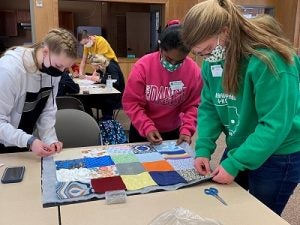Sewing skills may be hard to come by these days, but not for these high school 4-H members. The Iowa State 4-H Council pledged their hands to larger service as they gathered for their spring retreat. In partnership with the Iowa Education Services for the Blind and Visually Impaired (IESBVI), council members put their skills to the test and learned new ones as they worked together to prepare and sew nine tactile blankets for Iowa youth who are blind or visually impaired.
“The goal of this project was to create tactile blankets that can be used by infants, young children and older children who are blind or visually impaired, to help engage them in their cognitive development,” explained Deena Recker with the Iowa Education Services for the Blind and Visually Impaired.
The mission of the IESBVI is to enable Iowa’s students who are blind or visually impaired to function as independently as possible in all aspects of life by providing appropriate educational opportunities, resources and support services.
Last spring Recker connected with Haley Jones, leadership and civic engagement specialist with the Iowa 4-H program and adviser to the State 4-H Council. COVID-19 cancellations and winter weather delayed the service project partnership for nearly a year.

The State 4-H Council is composed of 40 energetic and leadership driven high school 4-H members who serve as ambassadors for the Iowa 4-H program.
“When Deena reached out last spring, I knew this was something our State Council members would be up for. I like to challenge them professionally and as their adviser, I look for ways to engage them in new experiences, especially when service and leadership are involved,” shared Jones.
From pinning the fabric and sewing squares together, to ironing the folds and sewing the backing on, council members completed the entire project as a team. Small groups and stations were formed in the large space, as members completed certain steps of the process before handing a blanket off to the next station to be worked on.
“My favorite part of this project was learning how useful the blankets are for visually impaired youth and being able to work with my fellow council members to create something that would mean a lot for another group of people,” shared Jake Lahr from Hamilton County.
One way that the Iowa Education Services for the Blind and Visually Impaired serves their students is through volunteer collaboration to make tactile blankets. These tactile blankets are specifically designed to be used with children up to three years old and with students who are cognitively delayed operating in that age range. Last year, the organization distributed over 100 tactile blankets to their staff who then placed the blankets with students.
“These blankets made by 4-H members provide an important way for the children we serve to begin reaching out into the world away from their bodies. Invaluable!” exclaimed Recker.
Council members were encouraged to take this service project idea back to their own counties and 4-H clubs to help spread awareness and to encourage their fellow 4-H members to sew tactile blankets for the visually impaired in Iowa.
“I think the service project was a great opportunity to help give back in a unique way. When someone says the words service project, I feel people tend to think physical labor, however, service is so much more than that. I had no idea that these blankets were such a need, but throughout the project I learned more about the purpose and necessity of the blankets. It was uplifting to be a part of a project with the entire state council,” shared Natalie Marr, state council member from Chickasaw County.
To get involved in sewing tactile blankets or to learn more about the Iowa Education Services for the Blind and Visually Impaired visit their website. To learn more about the State 4-H Council or the Iowa 4-H program, visit the Iowa State Extension website.


